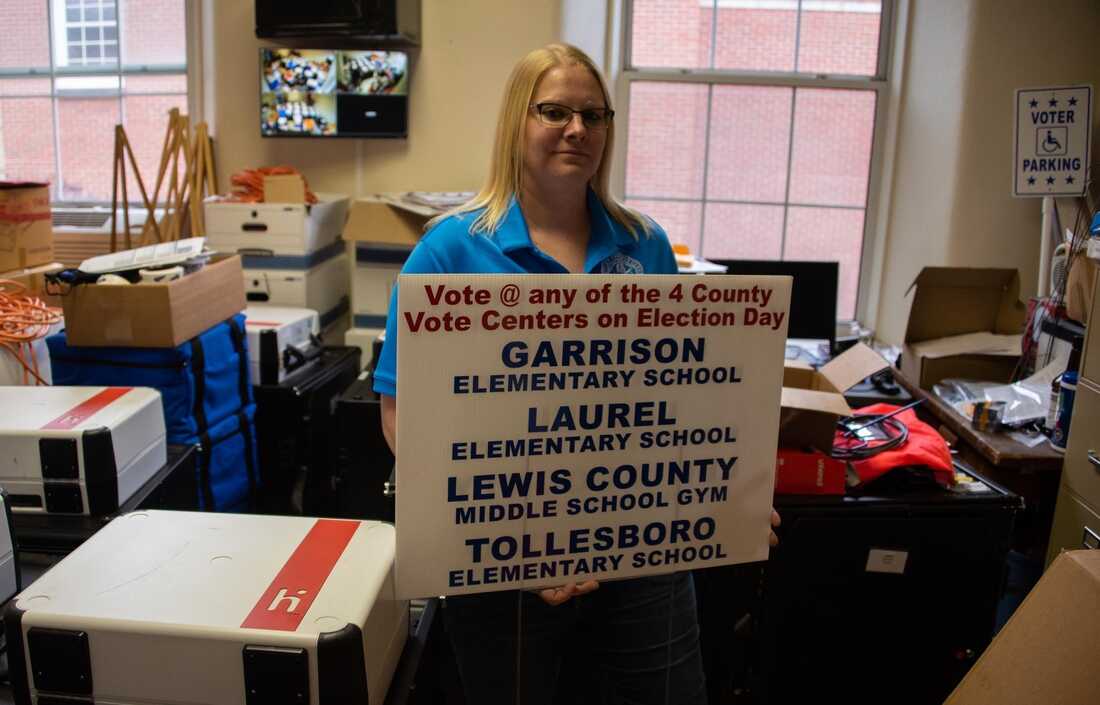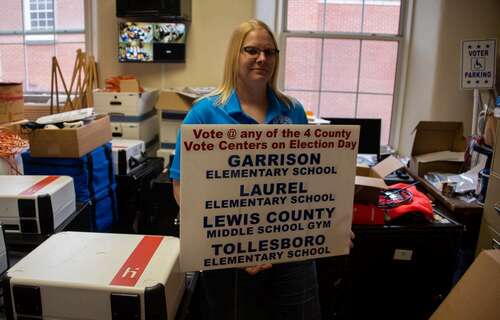
Leslie Collier, a Republican, is the county clerk in Lewis County, Ky. Her local board of elections consolidated 14 precinct-based voting locations in favor of just four countywide vote centers.
Justin Hicks/Kentucky Public Radio
hide caption
toggle caption
Justin Hicks/Kentucky Public Radio

Leslie Collier, a Republican, is the county clerk in Lewis County, Ky. Her local board of elections consolidated 14 precinct-based voting locations in favor of just four countywide vote centers.
Justin Hicks/Kentucky Public Radio
LOUISVILLE, Ky. — With nearly 500 square miles of bucolic rolling hills and cow pastures and only 13,000 people, Lewis County in northeastern Kentucky is one of the most sparsely populated places in the state.
The county is divided up into 14 voting precincts. For decades, each had its own voting location. But for this year’s general election, which ends Tuesday, Lewis County will only have four centralized polling sites.
“I know there’s gonna be hurt feelings,” Lewis County Clerk Leslie Collier said. “I just — it’s not done with malice. It’s just we don’t have any money. What do you do?”
Collier, a Republican, is trying her hardest to balance convenient and accessible voting with a shoestring budget. With the $50,000 the local government allocates annually, she struggles to keep voting machines up-to-date and poll workers paid. So this election, they’re trying to stretch that budget further by offering four centers where anyone in the county can vote, regardless of precinct.
“It was a tough decision [with] the County Board of Elections,” she said. “There were doubts, and a lot of discussion, but it was kind of something that we had to do just money-wise. Elections are important, but I also think that it’s important to spend that money on different projects, whether that’s roads or whatever.”
Even though she wasn’t required to, during this year’s primary Collier printed vinyl yard signs and put them in all the precincts people had voted at for decades.
She said she watched the primary voter turnout closely, and with it only dropping by 1 percentage point compared to the 2019 primary, she’s hopeful this could be a good strategy for elections like this year’s, without a presidential election, when turnout is typically a little lower.
“This fall … we’ll see if it stands the test of time,” she said. “I’m pretty sure that we can make it work.”
Collier isn’t alone in consolidating polling locations. For this election, 64 of Kentucky’s 120 counties have switched from a slew of neighborhood polling locations to using just a few centralized vote centers. Last year, 59 counties were exclusively using vote centers.
Kentucky Secretary of State Michael Adams, also a Republican, says like several states, the change to vote centers was really brought on by the pandemic. What started as a temporary pandemic measure was enshrined in state law in 2021.
“It turned out to be so popular that voters wanted to keep it, so we did,” Adams said.
But Adams says he has serious concerns about the vote centers in some places, including Lewis County. Having fewer voting locations can disenfranchise voters and mean there are fewer backups if something goes wrong, like a power outage or a violent incident.
Adams says he called Collier to discuss his worries with her consolidation, and told her he’d be watching the county’s voter turnout closely this election.
“This is something that you have legislators in both parties getting more and more frustrated about,” Adams said. “Like, ‘We gave you this law to expand access. If you abuse it, we’re just going to take it away from you.’ We’re not there yet, but we’re watching it.”

Kentucky Secretary of State Michael Adams speaks with reporters after voting early in Louisville on Thursday. Adams, a Republican, is running for reelection.
Justin Hicks/Kentucky Public Radio
hide caption
toggle caption
Justin Hicks/Kentucky Public Radio
For future elections, Secretary Adams says he wants state lawmakers to implement guard rails to prevent too much polling place consolidation.
“What I’d like is something that’s very, very clear black and white that says, ‘You’ve got to have no more than X thousand voters to vote at one location,’ ” he said. “It can’t be sort of, ‘I know it when I see it.’ It’s got to be specific.”
Megan Bellamy is with the national Voting Rights Lab, a group that favors expanded voting access. She says since the pandemic they’ve seen nearly 100 bills concerning vote centers filed in states across the country. And Bellamy says the adoption of the vote center model doesn’t really seem to be partisan either — it’s more of a rural versus urban issue.
“Urban centers may not have the same need to create a vote center,” Bellamy said. “It’s already convenient enough, it’s accessible enough … versus in some of the more rural areas where they’re looking to maybe fill some gaps when it comes to their funding.”
While her group primarily advocates for vote centers to be used in addition to precinct-based locations and laws that protect against disenfranchisement, Bellamy says consolidation isn’t all bad.
“Where you’re thinking about convenience, and all those factors that we outlined, it’s working for many voters,” Bellamy said.
Back in Kentucky, Secretary Adams says some counties are set to get some more funding for new technology. That could mean more places to vote in next year’s presidential election, when turnout is expected to be higher.




